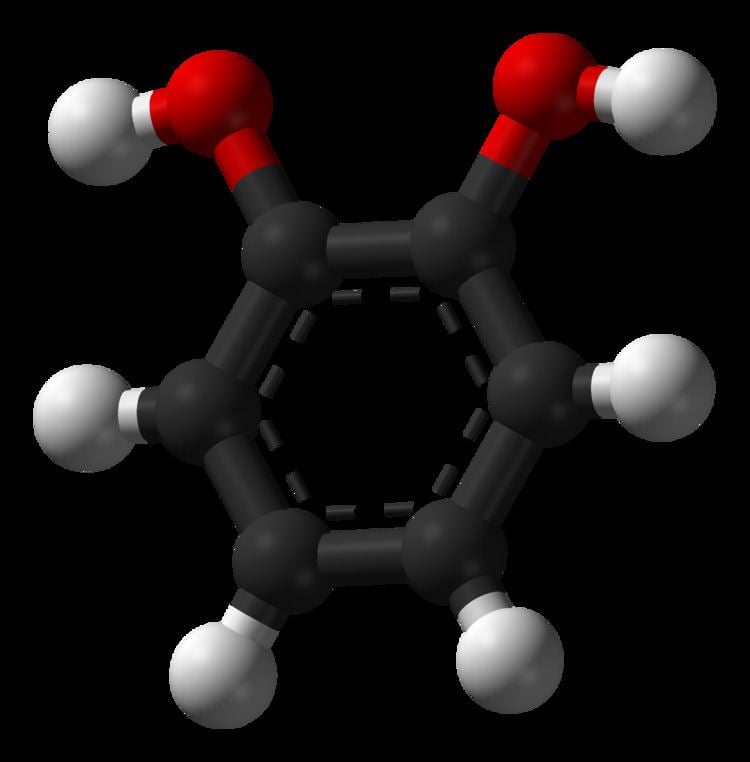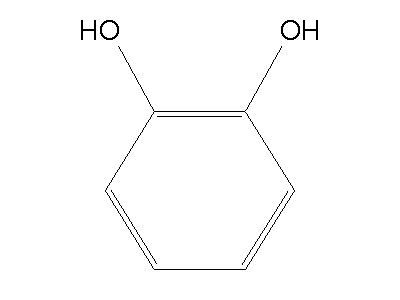Related compounds Molar mass 110.1 g/mol | Formula C6H6O2 Density 1.34 g/cm³ | |
Appearance white to brown feathery crystals | ||
Catechol (/ˈkætᵻtʃɒl/), also known as pyrocatechol or 1,2-dihydroxybenzene, is an organic compound with the molecular formula C6H4(OH)2. It is the ortho isomer of the three isomeric benzenediols. This colorless compound occurs naturally in trace amounts. It was first discovered by destructive distillation of the plant extract catechin. About 20 million kg are now synthetically produced annually as a commodity organic chemical, mainly as a precursor to pesticides, flavors, and fragrances.
Contents
- Isolation and synthesis
- Organic chemistry
- With metal ions
- Redox chemistry
- Natural occurrences
- Presence of the catechol moiety
- Uses
- Catechol derivatives
- Nomenclature
- References

Catechol occurs as feathery white crystals that are very rapidly soluble in water.
(The name "catechol" has also been used as a chemical class name, where it refers generally to the catechins.)
Isolation and synthesis

Catechol was first isolated in 1839 by Edgar Hugo Emil Reinsch (1809 - 1884) by distilling it from the solid tannic preparation catechin, which is the residuum of catechu, the boiled or concentrated juice of Mimosa catechu (Acacia catechu L.f). Upon heating catechin above its decomposition point, a substance that Reinsch first named Brenz-Katechusäure (burned catechu acid) sublimated as a white efflorescence. This was a thermal decomposition product of the flavanols in catechin. In 1841, both Wackenroder and Zwenger independently rediscovered catechol; in reporting on their findings, Philosophical Magazine coined the name pyrocatechin. By 1852, Erdmann realized that catechol was benzene with two oxygen atoms added to it; in 1867, August Kekulé realized that catechol was a diol of benzene, so by 1868, catechol was listed as pyrocatechol. In 1879, the Journal of the Chemical Society recommended that catechol be called "catechol", and in the following year, it was listed as such.

Catechol has since been shown to occur in free-form naturally in kino and in beechwood tar. Its sulfonic acid has been detected in the urine of horses and humans.
Catechol is produced industrially by the hydroxylation of phenol using hydrogen peroxide.
C6H5OH + H2O2 → C6H4(OH)2 + H2OPreviously, it was produced by hydroxylation of salicylaldehyde using hydrogen peroxide, as well as the hydrolysis of 2-substituted phenols, especially 2-chlorophenol, with hot aqueous solutions containing alkali metal hydroxides. Its methyl ether derivative, guaiacol, converts to catechol via hydrolysis of the CH3-O bond as promoted by hydriodic acid.
Organic chemistry
Like other difunctional benzene derivatives, catechol readily condenses to form heterocyclic compounds. Cyclic esters are formed upon treatment with phosphorus trichloride and phosphorus oxychloride, carbonyl chloride, and sulphuryl chloride:
C6H4(OH)2 + XCl2 → C6H4(O2X) + 2 HClwhere X = CO, SO2, PCl, P(O)ClCatechols produce quinones with the addition of ceric ammonium nitrate (CAN).
With metal ions
Catechol is the conjugate acid of a chelating agent used widely in coordination chemistry. Basic solutions of catechol react with iron(III) to give the red [Fe(C6H4O2)3]3−. Ferric chloride gives a green coloration with the aqueous solution, while the alkaline solution rapidly changes to a green and finally to a black color on exposure to the air. Iron-containing dioxygenase enzymes catalyze the cleavage of catechol.
Redox chemistry
Catechol is produced by a reversible two-electron, two-proton reduction of 1,2-benzoquinone (E° = +795 mV vs SHE; Em (pH 7) = +380 mV vs SHE).
The redox series catecholate dianion, monoanionic semiquinonate, and benzoquinone are collectively called dioxolenes. Dioxolenes are used as ligands.
Natural occurrences
Small amounts of catechol occur naturally in fruits and vegetables, along with the enzyme polyphenol oxidase (also known as catecholase, or catechol oxidase). Upon mixing the enzyme with the substrate and exposure to oxygen (as when a potato or apple is cut and left out), the colorless catechol oxidizes to reddish-brown melanoid pigments, derivatives of benzoquinone. The enzyme is inactivated by adding an acid, such as lemon juice. Excluding oxygen also prevents the browning reaction. However, the activity of the enzyme increases in cooler temperatures. Benzoquinone is said to be antimicrobial, which slows the spoilage of wounded fruits and other plant parts.
It is one of the main natural phenols in argan oil.
Pyrocatechol is also found in Agaricus bisporus.
It is also a component of castoreum, a substance from the castor gland of beavers, used in perfumery.
Presence of the catechol moiety
Catechol moieties are also found widely within the natural world. Arthropod cuticle consists of chitin linked by a catechol moiety to protein. The cuticle may be strengthened by cross-linking (tanning and sclerotization), in particular, in insects, and of course by biomineralization. Catechols such as DHSA are produced through the metabolism of cholesterol by bacteria such as Mycobacterium tuberculosis.
Urushiols are naturally existing organic compounds that have the catechol skeleton structure and diphenol functionality but with alkyl groups substituted onto the aromatic ring. Urushiols are the skin-irritating poisons found in plants like poison ivy, etc. Catecholamines are biochemically significant hormones/neurotransmitters that are phenethylamines in which the phenyl group has a catechol skeleton structure.
Parts of a molecule of catechin, another natural compound present in tea, contains a catechol group.
Uses
Approximately 50% of synthetic catechol is consumed in the production of pesticides, the remainder being used as a precursor to fine chemicals such as perfumes and pharmaceuticals. It is a common building block in organic synthesis. Several industrially significant flavors and fragrances are prepared starting from catechol. Guaiacol is prepared by methylation of catechol and is then converted to vanillin on a scale of about 10M kg per year (1990). The related monoethyl ether of catechol, guethol, is converted to ethylvanillin, a component of chocolate confectioneries. 3-Trans-Isocamphylcyclohexanol, widely used as a replacement for sandalwood oil, is prepared from catechol via guaiacol and camphor. Piperonal, a flowery scent, is prepared from the methylene diether of catechol followed by condensation with glyoxal and decarboxylation.
Catechol is used as a black-and-white photographic developer, but, except for some special purpose applications, its use is largely historical. It is rumored to have been used briefly in Eastman Kodak's HC-110 developer and is rumored to be a component in Tetenal's Neofin Blau developer. It is a key component of Finol from Moersch Photochemie in Germany. Modern catechol developing was pioneered by noted photographer Sandy King. His "PyroCat" formulation is popular among modern black-and-white film photographers. King's work has since inspired further 21st-century development by others such as Jay De Fehr with Hypercat and Obsidian Acqua developers, and others.
Catechol derivatives
The catechol skeleton occurs in a variety of natural products such as urushiols, which are the skin-irritating poisons found in plants like poison ivy, and catecholamines, drugs imitating them (such as MDMA), hormones/neurotransmitters, and catechin, which is found in tea. Many pyrocatechin derivatives have been suggested for therapeutic applications.
Nomenclature
Although rarely encountered, the officially "preferred IUPAC name" (PIN) of catechol is benzene-1,2-diol. The trivial name pyrocatechol is a retained IUPAC name, according to the 1993 Recommendations for the Nomenclature of Organic Chemistry.
